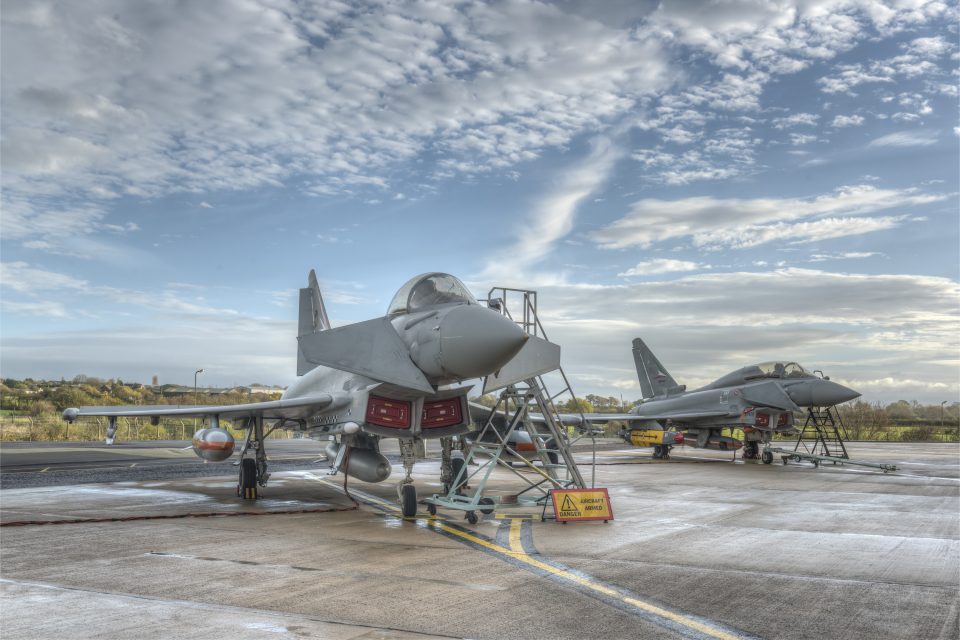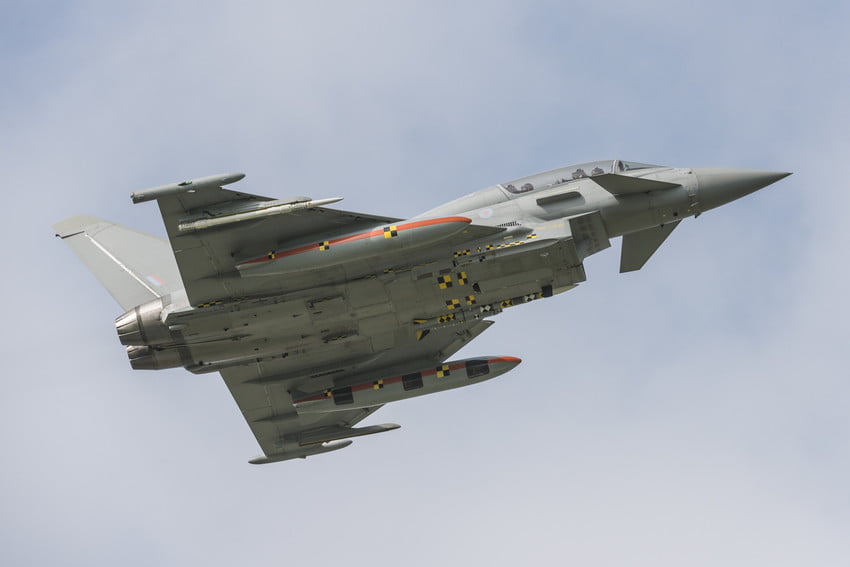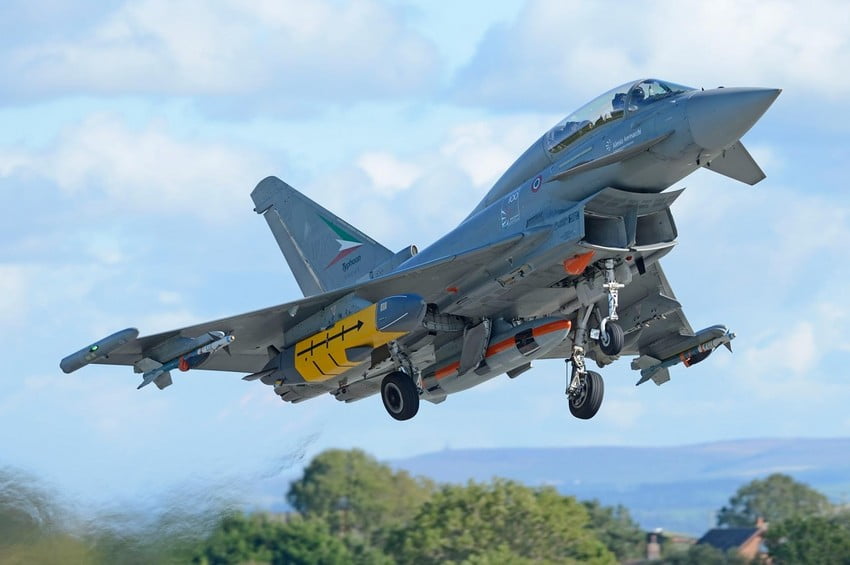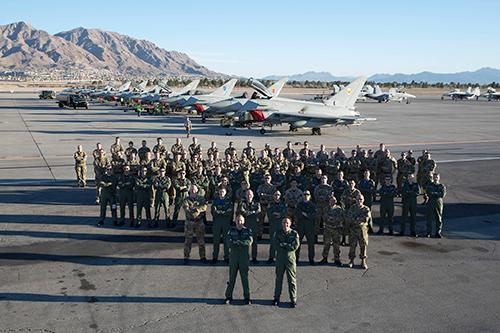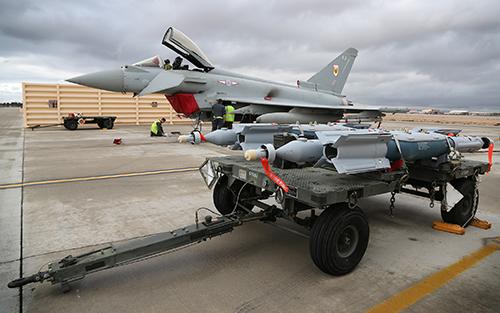2016-05-12 By Robbin Laird
I returned to the European Air Group on April 27, 2016 to participate in their latest working group session of 4th/5th generation aircraft integration.
Here the continued focus is upon how the coming of the F-35 is part of the reshaping of European airpower and enabling 4th generation in the words of a Typhoon pilot to become “more lethal and survivable.”
But during my visit, I was able to talk with the Typhoon integration-working group.
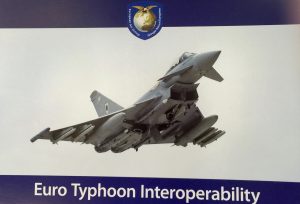
The session was led by Brigadier General de Ponti, Deputy Director, of the European Air Group and joined by the “drivers” of the ETIP (Euro Typhoon Interoperability Project) as well as organizers of exercise efforts to shape a new approach, namely Lt. Col. Jacobo Lecube of the Spanish Air Force and Lt Col. Marco Schiattioni from the Italian Air Force and Chief of Staff Col. Stephane Pierre, of the Belgian Air Force.
The overall focus of the effort is upon shaping a more common fleet approach among Eurofighter nations.
Although four nations came together to build a common airplane, the planes have been used by four different air forces with limited overlap in standards and operating practices.
As the Euro-Typhoon is clearly a key element for the future of European airpower and with the coming of the F-35 to Europe, this makes little sense.
And what the European Air Group is focused upon are practical ways to shape more common fleet approaches among the air forces, which fly Euro-Typhoon.
Also, shaping a common template in doing Baltic air policing in which Eurofighter/Typhoons are becoming a frequent asset in executing the mission provides an obvious opportunity to find ways to shape common procedures and support approaches as well.
The problem was simply put by one of the participants:
“When an Italian Eurofighter lands on a German base, it can not use the ground support equipment or change a tire, because the standards are different.
These are procedural issues, which may make sense in terms of national norms but not in terms of common fleet operations.
Through this project we seek to end differences which get in the way of common operational support.”
According to BG de Ponti:
“The Eurofighter-Typhoon project is an important effort for our air forces.
It is about the co-evolution of Typhoon with the shaping of a 4th-5th generation integrated force.
It is two prongs of shaping more effective European airpower.
It is a building blocks approach to shaping evolving capabilities.”
The focus is upon achieving practical steps towards greater integration of the Eurofighter-Typhoon based on the working together of the crews to shape common approaches and capabilities.
The EAG is leveraging an exercise approach to shape a way ahead.
According to Lt Col. Schiattioni:
“We started as a normal forum, but quickly realized that we needed to shape an exercise approach.
From the beginning, the Tornado had a much more common operational approach than with Typhoons.
Although the jet was built together, each nation did its own training and TTPs.
Each nation operated the jet differently.
But now that we operate more together, we need clear common operating procedures, notably with regard to maintenance of the aircraft.
In turn, this drives a wedge in common modernization which needs to be done with the broader fleet.”
The approach is based on sharing information and to get the pilots and maintainers to together to share experiences and to shape common standards.
Lt Col. Schiattioni underscored that “We managed to get the key people for each air force responsible for the standards for their national aircraft to shape a more global approach to standards.
And also important was bringing the maintainers together to share lessons learned and to shape more common maintenance procedures.”
Lt. Col. Lecube emphasized that the program has been very industry driven which meant that the operational commonality was not the center of attention.
“But at the squadron level there has been a growing interest ways to shape more operational commonality.
The Baltic patrolling was a key driver for this approach as well.
With the Spanish and the British e.g. operating together in the Baltic Air Patrol, it is crucial to operate a common SOP in such operations.”
A key achievement clearly is to shape a more common SOP for operations and maintenance which, of course, will become even more important as the Tranche 3 standard comes into play for the Eurofighter nations.
Underlying the new approach is a broad agreement reached many years ago where the seven Eurofighter nations agreed to broad ways to work together but the EAG as in other areas is focused on driving practical solutions.
Lt Col. Schiattioni added: “The sharing of information can provide a better way to underscore how each nation can pursue modernization but sort out which among the Eurofighter nations is interested in a solution generated by a particular nation.
This will allow national, bi-national approaches which can drive innovation for the larger Eurofighter enterprise.”
In the words of one speaker at the 4th-5th generation working group, there was a clear need to modernize the Eurofighter approach to modernization.
Clearly, the EAG is making a key contribution to this effort.
Eurofighter/Typhoon Interoperability Exercise – Albacete AB (Spain)
Four nations (Germany, Italy, Spain and UK) of the European Air Group (EAG) conducted a multinational exercise, VOLCANEX Eurofighter Typhoon Interoperability Project (ETIP) LIVEX 15, from 14 – 18 September at Albacete Air Base (Spain).
The aim was to strengthen Eurofighter/Typhoon interoperability and standardization between the EAG nations through the use of common Standard Operating Procedures (SOP), and to familiarize ground crews on other nations AGE (Aircraft Ground Equipment),“Turn around” and QRA procedures.
The key to success in multinational operations is a common understanding and efficient coordination and communications between nations of what to do and how to do it.
The EAG, consisting of the Air Forces of Belgium, France, Germany, Italy, The Netherlands, Spain, and the United Kingdom, seeks to improve the operational capabilities of the Parties’ Air Forces to carry out operations in pursuit of shared interests.
One way of achieving this goal is by developing common doctrines and procedures. VOLCANEX is the European Air Group’s name for current and future multinational exercises on which it seeks to refine and validate its developed products and procedures.
IM OF VOLCANEX ETIP LIVEX 15
VOLCANEX ETIP LIVEX 15 was a week-long exercise primarily focused on achieving a common EAG SOP for Air Operations and to improve familiarization through the exchange of best practices among aircrew and maintenance personnel of the Eurofighter/Typhoon community.
The live Air Operation Exercise was conducted under the ‘Eurofight Technical Agreement’ at the Spanish Air Force Base of Albacete, taking advantage of the concomitant deployment of nation’s aircrafts for the Tactical Leadership Programme Flying Course.
The exercise, hosted by the 14 ALA of the Spanish Air Force, was directed by EAG personnel, together with the senior national representatives.
The level of experience amongst the participants allowed to the exercise objectives to be achieved quickly and in particular to establish a usable and valid SOP for Eurofighter/Typhoon operations.
A ‘bottom-up’ / operator-led approach encouraged participants to explore the specific tools needed for further development of interoperability within the community.
A full week’s program focused on interoperability where daily aircrews compared, discussed, and validated in flight, common procedures throughout the missions spectrum.
Meanwhile ground crews had the opportunity to familiarize with launch and recovery (see off/in) and QRA procedures and to demonstrate their own national AGE.
A total of 8 very highly experienced pilots and more than 18 engineers/ground crew personnel took an active part in VOLCANEX ETIP LIVEX 15 and 28 total sorties were flown.
“The achievement of a Common SOP is a milestone in the development of future combined training and operations for the Eurofighter/Typhoon community.
`For instance, we are providing a useful tool for the operators to be employed in the Baltic air-policing mission where the four nations are currently involved.` said Lt Col Jacobo Lecube, member of the EAG permanent staff and Exercise Director.
It was also the first time that this Exercise was focused on 1st line maintenance interoperability issues, providing not only the opportunity to discuss and share best practices, but also to observe and practice together in order to identify possible tools and ways ahead for a better interoperability on future combined scenarios.
http://www.euroairgroup.org/project/etip-meeting-grosseto/
The EAG describes the project as follows on its website:
In September 2011, the Eurofighter operating community comprising 4 EAG Nations (Germany, Italy, Spain and the United Kingdom), two additional Eurofighter users (Austria and Saudi Arabia), NETMA and the Industry, signed the Typhoon User
Group (TUG) Agreement.
The Agreement aimed to provide an open forum for the exchange of operational, capability, sustainability and maintainability views and develop best practice within the Eurofighter-Typhoon operator community, industry and for other potential users.
The EAG Nations felt that they needed to coordinate and exchange information at the tactical/operational/operating level in order:
- To improve the coordination of flight safety activity amoung the Typhoon Nations,
- To organize an annual conference to share TTPs at Squadron level,
- To organize an annual conference for Operational Conversion Units (OCU).
The Euro Typhoon Interoperability Project, created in September 2013, seeks to work on these issues at tactical level, in order to developed improved interoperability between the EAG Eurofighter and Typhoon nation’s aircrews and supporting staff.
The main objectives agreed by the nations and established in the ToRs are as follows:
- Improve coordination between the different Eurofighter and Typhoon squadrons.
- Improve flight safety at the user level.
- Share crew certification criteria.
- Improve mission planning knowledge and capability.
- Share information at the tactical level (TTPs).
- Improve the sharing of the day-to-day troubleshooting and basic maintenance issues.
- Share instructional syllabus and improve the Initial Basic Instruction and coordination of training activities at the OCUs.
- Coordinate as much as possible, deployments and exercises for mutual benefits.
http://www.euroairgroup.org/project/euro-typhoon-interoperability-project/
For our report on Eurofighter modernization, see the following:
https://sldinfo.com/a-special-report-on-eurofighter-modernization-shaping-a-way-ahead/
https://sldinfo.com/wp-content/uploads/2015/11/An-Update-on-Eurofighter-Modernization.pdf
The first slideshow shows various photos of the typhoons.
The first photo shows the Typhoons in the formation along with the F-35 crossing the Atlantic and is credited to the Italian Ministry of Defence.
The second and third show RAF Typhoons involved in Red Flag 2015.
The fourth shows the Typhoon with the Storm Shadow.
The fifth shows the Typhoon with a Meteor missile.
And the final photo shows the Typhoon with both Storm Shadow and Meteor.
The second slideshow shows Typhoons during the EAG Typhoon interoperability exercise in Spain and the photos are credited to the Spanish Air Force and the European Air Group.
The video below shows Typhoons from RAF 3rd Squadron (based at Coningsby) participating in Red Flag 16-1.
Red Flag 16-1 Continues from SldInfo.com on Vimeo.



